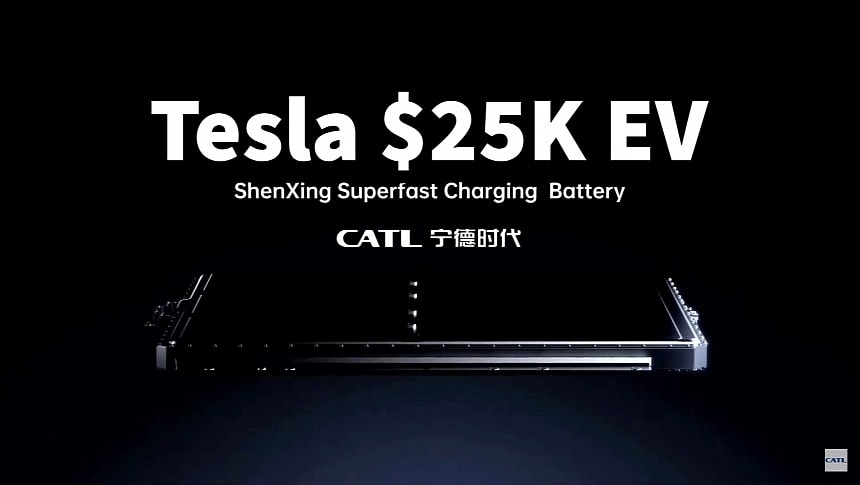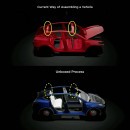Tesla is close to a breakthrough with its self-driving software, making Elon Musk confident that his company could solve vehicle autonomy. FSD Beta's success also boosts Tesla's robotaxi plans, with the EV maker looking for partners to make the next-generation EVs a reality. On the battery front, CATL emerged as the most likely partner thanks to its high-performance, low-cost LFP cells.
Tesla has been cozying with the idea of an affordable electric vehicle since Elon Musk introduced Master Plan Part Deux in 2016. However, the health crisis in 2020 and supply chain woes that followed raised car prices through the roof. In 2022, Tesla could double the price of its electric vehicles and still not build enough of them to quench demand, so the idea of an affordable EV did not make sense.
However, toward the end of 2022, people around Musk worked to convince Musk that a more affordable EV would be critical to Tesla's plans to build 20 million cars per year by 2030. According to Walter Isaacson's book, Musk eventually agreed to make the affordable EV alongside the Tesla robotaxi using the same Gen-3 architecture. On March 1, during the Investor Day, Tesla announced plans for a new type of gigafactory in Mexico, as well as the unboxed vehicle manufacturing process.
Plans have changed a little since then, with the next-generation EV's production now planned to start at Giga Texas instead of Giga Mexico. The change was reportedly made to accelerate the development, with the latest rumors indicating that Tesla targets the start of trial production in June 2025. During the Q4 2023 earnings call, Tesla revealed that the upcoming compact EV has been baptized internally as Project Redwood.
There are very few details about Tesla's mass-market electric car, but we know that it will have to be built at cost to make the $25,000 price sustainable. This is why Musk talking about adding the compact EV to Giga Berlin production doesn't make much sense, cost-wise. Giga Berlin undoubtedly has high production costs, which is why Tesla needs to think of a country with cheaper labor costs than Germany.
Part of making the next-gen EVs as cost-effective as possible is finding the right suppliers and components that make sense. Since the battery pack is arguably the most expensive component of an electric vehicle, it's also where you can save the most by making wise decisions. Not surprisingly, Tesla is considering using lithium-iron-phosphate (LFP) cells for its Gen-3 vehicles. LFP cells are about a third cheaper than NMC cells but have lower energy density.
However, the latest advancements in LFP tech have improved these cells to the point that they can better compete with nickel-based cells. CATL and BYD are the leaders in LFP cell production, and Tesla is already working with both. However, recent reports show that Tesla is betting on CATL to supply the LFP cells for the $25,000 model.
Earlier reports indicated that Tesla aims to expand its battery production facility in Sparks, Nevada, using idle equipment from CATL. Given the small production capacity of under 10 GWh per year, this will likely be used for research purposes. A recent Bloomberg piece indicates that CATL and Tesla will also work together to improve LFP chemistry, notably allowing faster charging and higher energy density.
However, toward the end of 2022, people around Musk worked to convince Musk that a more affordable EV would be critical to Tesla's plans to build 20 million cars per year by 2030. According to Walter Isaacson's book, Musk eventually agreed to make the affordable EV alongside the Tesla robotaxi using the same Gen-3 architecture. On March 1, during the Investor Day, Tesla announced plans for a new type of gigafactory in Mexico, as well as the unboxed vehicle manufacturing process.
Plans have changed a little since then, with the next-generation EV's production now planned to start at Giga Texas instead of Giga Mexico. The change was reportedly made to accelerate the development, with the latest rumors indicating that Tesla targets the start of trial production in June 2025. During the Q4 2023 earnings call, Tesla revealed that the upcoming compact EV has been baptized internally as Project Redwood.
There are very few details about Tesla's mass-market electric car, but we know that it will have to be built at cost to make the $25,000 price sustainable. This is why Musk talking about adding the compact EV to Giga Berlin production doesn't make much sense, cost-wise. Giga Berlin undoubtedly has high production costs, which is why Tesla needs to think of a country with cheaper labor costs than Germany.
Part of making the next-gen EVs as cost-effective as possible is finding the right suppliers and components that make sense. Since the battery pack is arguably the most expensive component of an electric vehicle, it's also where you can save the most by making wise decisions. Not surprisingly, Tesla is considering using lithium-iron-phosphate (LFP) cells for its Gen-3 vehicles. LFP cells are about a third cheaper than NMC cells but have lower energy density.
However, the latest advancements in LFP tech have improved these cells to the point that they can better compete with nickel-based cells. CATL and BYD are the leaders in LFP cell production, and Tesla is already working with both. However, recent reports show that Tesla is betting on CATL to supply the LFP cells for the $25,000 model.
Earlier reports indicated that Tesla aims to expand its battery production facility in Sparks, Nevada, using idle equipment from CATL. Given the small production capacity of under 10 GWh per year, this will likely be used for research purposes. A recent Bloomberg piece indicates that CATL and Tesla will also work together to improve LFP chemistry, notably allowing faster charging and higher energy density.









